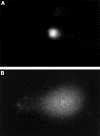Cell cycle dependent DNA break increase in ataxia telangiectasia lymphoblasts after radiation exposure
- PMID: 11577178
- PMCID: PMC1187093
- DOI: 10.1136/mp.54.5.347
Cell cycle dependent DNA break increase in ataxia telangiectasia lymphoblasts after radiation exposure
Abstract
The most striking feature of ataxia telangiectasia (AT) cells is their profound sensitivity to ionising radiation. A deficiency in the rejoining of radiation induced DNA breaks has been suggested to be responsible for AT radiosensitivity; however, the existing literature is controversial. A subpopulation, which is present in irradiated AT lymphoblasts, but rarely in controls, has been reported previously. The cells that make up this subpopulation harbour highly fragmented DNA and are responsible for the overall increase in DNA breaks soon after irradiation in AT lymphoblasts. This study examines the influence of the cell cycle on the highly damaged subpopulation. The frequency of highly damaged cells was highest when AT lymphoblasts were irradiated during the G2/M phase. In contrast, AT lymphoblasts irradiated during the G0/G1 phase displayed a frequency similar to control cells. Thus, only G2/M and to some extent S phase cells contribute to an increased DNA break number in AT lymphoblasts early after irradiation. These findings might explain several inconsistencies reported in the literature.
Figures


Similar articles
-
Elevated frequency of p53-independent apoptosis after irradiation increases levels of DNA breaks in ataxia telangiectasia lymphoblasts.Int J Radiat Biol. 1997 Sep;72(3):257-69. doi: 10.1080/095530097143257. Int J Radiat Biol. 1997. PMID: 9298106
-
Radiosensitivity in ataxia-telangiectasia: anomalies in radiation-induced cell cycle delay.Int J Radiat Biol. 1994 Feb;65(2):175-84. doi: 10.1080/09553009414550211. Int J Radiat Biol. 1994. PMID: 7907115
-
Ionizing radiation and cell cycle progression in ataxia telangiectasia.Radiat Res. 1994 Apr;138(1 Suppl):S130-3. Radiat Res. 1994. PMID: 8146316
-
Cellular radiosensitivity in ataxia-telangiectasia.Int J Radiat Biol. 1994 Dec;66(6 Suppl):S87-96. Int J Radiat Biol. 1994. PMID: 7836857 Review.
-
Regulation of the cell cycle following DNA damage in normal and Ataxia telangiectasia cells.Experientia. 1996 Apr 15;52(4):316-28. doi: 10.1007/BF01919534. Experientia. 1996. PMID: 8620934 Review.
Cited by
-
Ataxia-Telangiectasia Mutated Modulation of Carbon Metabolism in Cancer.Front Oncol. 2017 Nov 29;7:291. doi: 10.3389/fonc.2017.00291. eCollection 2017. Front Oncol. 2017. PMID: 29238697 Free PMC article. Review.
-
ATM controls proper mitotic spindle structure.Cell Cycle. 2014;13(7):1091-100. doi: 10.4161/cc.27945. Epub 2014 Feb 6. Cell Cycle. 2014. PMID: 24553124 Free PMC article.
-
ATM activates the pentose phosphate pathway promoting anti-oxidant defence and DNA repair.EMBO J. 2011 Feb 2;30(3):546-55. doi: 10.1038/emboj.2010.330. Epub 2010 Dec 14. EMBO J. 2011. PMID: 21157431 Free PMC article.
References
-
- Gatti RA. Ataxia telangiectasia. In: Vogelstein B, Kinzler KW, eds. The genetic basis of human cancer. Baltimore: MacGraw-Hill, 1997:275–300.
-
- Jorgensen TJ, Shiloh Y. The ATM gene and the radiobiology of ataxia-telangiectasia. Int J Radiat Biol;1996:69:527–37. - PubMed
-
- Lavin MF, Shiloh Y. The genetic defect in ataxia-telangiectasia. Annu Rev Immunol 1997;15:177–202. - PubMed
-
- Taylor AMR, Harnden DG, Arlett CF, et al. Ataxia telangiectasia: a human mutation with abnormal radiation sensitivity. Nature 1975;258:427–8. - PubMed
-
- Lehmann AR, Stevens S. The production and repair of double stranded breaks in cells from normal humans and from patients with ataxia telangiectasia. Biochim Biophys Acta 1977;474:49–60. - PubMed
Publication types
MeSH terms
LinkOut - more resources
Full Text Sources
Medical
